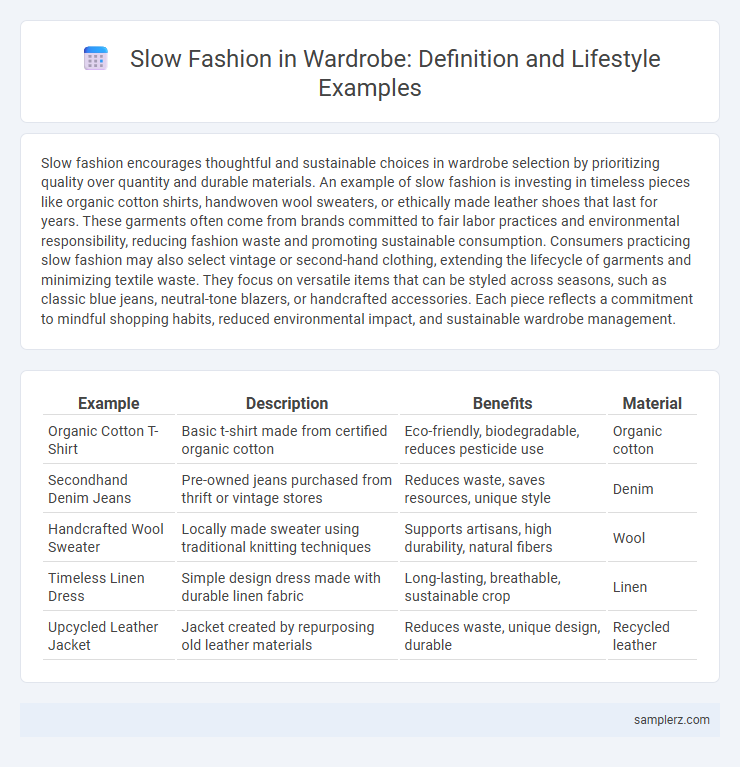Slow fashion encourages thoughtful and sustainable choices in wardrobe selection by prioritizing quality over quantity and durable materials. An example of slow fashion is investing in timeless pieces like organic cotton shirts, handwoven wool sweaters, or ethically made leather shoes that last for years. These garments often come from brands committed to fair labor practices and environmental responsibility, reducing fashion waste and promoting sustainable consumption. Consumers practicing slow fashion may also select vintage or second-hand clothing, extending the lifecycle of garments and minimizing textile waste. They focus on versatile items that can be styled across seasons, such as classic blue jeans, neutral-tone blazers, or handcrafted accessories. Each piece reflects a commitment to mindful shopping habits, reduced environmental impact, and sustainable wardrobe management.
Table of Comparison
| Example | Description | Benefits | Material |
|---|---|---|---|
| Organic Cotton T-Shirt | Basic t-shirt made from certified organic cotton | Eco-friendly, biodegradable, reduces pesticide use | Organic cotton |
| Secondhand Denim Jeans | Pre-owned jeans purchased from thrift or vintage stores | Reduces waste, saves resources, unique style | Denim |
| Handcrafted Wool Sweater | Locally made sweater using traditional knitting techniques | Supports artisans, high durability, natural fibers | Wool |
| Timeless Linen Dress | Simple design dress made with durable linen fabric | Long-lasting, breathable, sustainable crop | Linen |
| Upcycled Leather Jacket | Jacket created by repurposing old leather materials | Reduces waste, unique design, durable | Recycled leather |
Defining Slow Fashion in Everyday Wardrobes
Slow fashion in everyday wardrobes emphasizes quality over quantity, prioritizing timeless pieces made from sustainable materials such as organic cotton, linen, and recycled fabrics. Consumers adopt mindful shopping habits by choosing ethically produced garments that support fair labor practices and reduce environmental impact. Incorporating versatile basics, vintage finds, and minimalistic styles extends the lifecycle of clothing, promoting a more conscious and eco-friendly approach to fashion consumption.
Key Characteristics of a Slow Fashion Wardrobe
A slow fashion wardrobe emphasizes quality over quantity, featuring timeless, durable pieces made from sustainable materials such as organic cotton, linen, and recycled fabrics. It prioritizes ethical production methods, including fair labor practices and environmentally friendly dyeing processes. Key characteristics include versatility, minimalism, and intentional purchasing, reducing waste and encouraging long-term use.
Capsule Wardrobe: Embracing Minimalist Choices
A capsule wardrobe exemplifies slow fashion by prioritizing quality over quantity, featuring timeless, versatile pieces that seamlessly mix and match. Key items often include neutral-toned basics like tailored trousers, classic white shirts, and durable knitwear crafted from sustainable materials such as organic cotton or recycled fibers. This minimalist wardrobe reduces waste and clutter while encouraging mindful consumption aligned with eco-friendly and ethical fashion principles.
Timeless Fabrics: Choosing Quality Over Quantity
Investing in timeless fabrics like organic cotton, linen, and wool promotes slow fashion by emphasizing durability and sustainability over fast-changing trends. High-quality materials retain their shape and color longer, reducing the need for frequent replacements and minimizing environmental impact. Choosing classic, well-crafted pieces encourages a minimalist wardrobe that supports ethical production and responsible consumption.
The Role of Handmade and Artisanal Clothing
Handmade and artisanal clothing exemplify slow fashion by emphasizing quality, durability, and unique craftsmanship over mass production. These garments often use sustainable materials and traditional techniques that reduce environmental impact and support local artisans. Incorporating handmade pieces into your wardrobe fosters mindful consumption and a distinctive, lasting style.
Investing in Versatile, Long-Lasting Pieces
Investing in versatile, long-lasting pieces such as a classic trench coat, high-quality denim jeans, and a tailored blazer exemplifies slow fashion by promoting durability and timeless style. These wardrobe staples reduce the need for frequent replacements, minimizing environmental impact and supporting sustainable consumption. Prioritizing neutral colors and adaptable designs ensures these items seamlessly integrate into multiple outfits, enhancing both functionality and longevity.
Upcycling: Giving New Life to Old Garments
Upcycling transforms old garments into unique, stylish pieces by creatively altering or combining fabrics, reducing textile waste and environmental impact. Techniques like patchwork, embroidery, and fabric dyeing enhance the original clothing, promoting sustainable fashion choices. This approach extends garment lifespan, supports circular fashion, and encourages mindful consumption in wardrobes.
Supporting Local and Ethical Fashion Brands
Supporting local and ethical fashion brands enhances wardrobe sustainability by reducing environmental impact and promoting fair labor practices. Incorporating handcrafted, eco-friendly garments from regional artisans ensures unique style while fostering community growth. This approach prioritizes quality over quantity, encouraging mindful consumption and lasting wardrobe value.
Seasonal Rotation for Sustainable Outfit Planning
Seasonal rotation in slow fashion involves curating a wardrobe that aligns with each season's weather and trends, reducing the need for excessive clothing purchases. This method promotes sustainability by prioritizing quality pieces that can be mixed and matched, extending their lifecycle while minimizing waste. Incorporating versatile items like knit sweaters, lightweight jackets, and durable boots ensures a functional yet eco-friendly approach to outfit planning throughout the year.
Caring for Clothes: Maintenance and Repair Rituals
Caring for clothes through regular maintenance and repair rituals extends the lifespan of slow fashion pieces, preserving their quality and reducing waste. Hand washing delicate fabrics, using gentle detergents, and air drying prevent damage and maintain texture. Mending small tears or replacing buttons promptly fosters a sustainable wardrobe by encouraging mindful consumption and reducing the need for frequent replacements.

example of slow fashion in wardrobe Infographic
 samplerz.com
samplerz.com